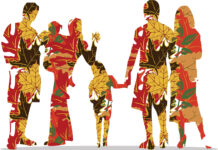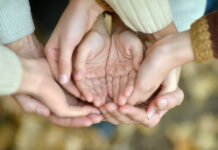The first time I saw a therapist was in 1981, when I was eight years old. Her name was Sharon. She had red hair and freckles, just like me. Once a week, my mother would take me to the Flatbush Guidance Center, where I would spend an hour talking to Sharon. My parents’ marriage had imploded a couple of years before and I was having trouble in school. Primarily, I was being teased and bullied for being a “sissy.” It would be eight years before I came out as gay to a largely supportive family. Throughout that time, I was in therapy on and off.
While I was in college, my family suffered a series of deaths, including a four-month period during which my 47-year-old uncle, my great-uncle, and my grandfather all died. The obsessive-compulsive behaviors and panic attacks I had suffered since middle school — and which I’d been self-medicating with weed, alcohol, and other drugs— became so severe that I withdrew from school for a semester. I met with a psychiatrist who diagnosed me with OCD and started me on medication. I started seeing a new therapist. I had good months and years and bad ones.
All along, my mother was my rock, my North Star, and the person who – no matter how awful my panic or OCD symptoms got – made me feel safe. By my 20s, I had accepted that I would have to live with OCD and panic. Despite them, I was a successful nonprofit fundraiser. At 28, I met my now-husband and moved in with him at 30. I became a workaholic and, by 35, became the head of fundraising for a nonprofit I’d admired since I was a teenager.
Despite my professional growth, my world was progressively shrinking. I had a lot of rules and methods to manage my anxiety. I stopped pushing myself. I avoided places and situations that provoked my anxiety. I couldn’t travel alone. I generally didn’t like being alone with my thoughts at all. I found a new therapist who urged me to stop being afraid of life, but it didn’t help. Eventually, the dream job became a nightmare. I was working 80 hours a week. I’d gained 30 pounds. My husband felt neglected. I had lots of panic attacks. I developed eczema on both eyelids. I was so stressed and terrified, my husband needed to walk me to work some days.
A significant portion of my OCD-related thoughts had revolved around harm befalling my mother. It was the worst thing I could imagine. My greatest hits included her falling down the stairs, dying in a plane crash while traveling to see her boyfriend in Maui, and being dragged into traffic by her crazy pit bull, Juliette. Another layer of my OCD-related thoughts focused on my own health. As a gay man who came of age in the early ’90s, dying from AIDS was a regular obsession, as was going blind and having brain cancer. At times I have been agoraphobic, hodophobic (fear of travel), and nyctophobic (fear of the dark) to the point of debilitation.
In August 2009, I managed to take a much-needed vacation with my husband, my mother, and a close friend. We had a fabulous time. During the trip, my mother urged me to find more in life than my job. She told me it wasn’t worth being so stressed-out and sick. When I returned from vacation, I resigned. I decided I wanted a job with less responsibility so I could have a more balanced life.
That period of calm lasted for six months.
On April 21, 2010, my mother— just 56 years old at the time —died from a Clostridioides difficile infection (CDI). CDI is a healthcare-associated infection (HAI), which until the early 2000s primarily affected the elderly and immune-compromised. Having been considered a nuisance disease by the healthcare industry since it was first identified in the 1970s, a newer strain was spreading to epidemic proportions and proving far deadlier. The time of my mother’s symptoms until her death was just six days.
Determined that our mother’s death would not be in vain, in the summer of 2010 my brother and I founded the Peggy Lillis Foundation (PLF). The grief from losing Mom was (and still is) a physical ache. My anger at the healthcare system that had stood by and let a so-called “nuisance disease” kill tens of thousands of Americans every year was an inferno in my gut. For the next few months, it felt as though all my fears and obsessive thoughts had vanished. At the time I said, “The worst thing that I could ever imagine has happened. What else is there to fear?”
That phase also lasted six months, and then my anxieties returned.
Running the PLF not only required all my skills and talents, but also meant confronting my mental health issues in a whole new way. Our vision for PLF was a national organization that used the story of our mother and others harmed by C. diff. infection to raise public awareness, engage and empower patients, and, ultimately, to shape policies to stop the epidemic. This was a difficult premise for someone frequently afraid to leave the house alone, who had panic attacks in airports, and couldn’t sleep with the lights off. I had to change.
My first approach to most problems is to research and understand them. I learned as much as I could about anxiety and OCD. This led me to the science of neuroplasticity, wherein we can proactively use our thoughts and behaviors to reshape the way our brains work. Since the mid-1990s, research has found that a combination of mindfulness and cognitive behavioral therapy (CBT) are very effective at decreasing OCD and anxiety symptoms. I spoke to both my current therapist and my psychiatrist about my goal of tackling my OCD and anxiety head on. They were both supportive, as was my husband and family. I had been “managing” my OCD and anxiety, seeking help or making lifestyle changes only when it became intolerable. The goal of creating a legacy for my mother that would end the harm caused by CDI required that I go beyond managing my symptoms to confronting OCD and anxiety at their roots. I had to fundamentally change my understanding of anxiety.
So I got some workbooks on CBT. I also read a bunch more books, most importantly The Imp of the Mind by Lee Baer and Rewind, Replay, Repeat by Jeff Bell. The former looks at OCD from a variety of clinical and cultural perspectives, while the latter is a memoir by someone who fought his way back from debilitating OCD. My therapist helped me engage in exposure and response-prevention therapies. She also taught me a great deal about mindfulness and meditation. I asked my husband and close friends to help by not giving into my reassurance-seeking, a compulsive behavior where people ask if their “what if” thoughts will come true. I became adept at bringing myself through panic attacks as well as knowing when I needed help from medication. More recently, I’ve been relabeling my stress and anxiety symptoms, not as threats to my safety but as mental and physical processes that are harmless. This shift, let me refocus my obsessive mind and anxiety energy so they are productive and not destructive.
Ten years into this journey, I am not “cured,” and I no longer see that as a goal. But I travel by myself frequently. I rarely feel agoraphobic. Panic attacks are a rarity. I have represented the Peggy Lillis Foundation at meetings with legislators, industry , and senior leaders in state and federal agencies. My mother’s story has reached millions of people. And we are beginning to see a decline in C. diff. transmission and related deaths in healthcare facilities.
Still, medical harm, including preventable infections like C. diff., is the third-leading cause of death in the United States. This is a national scandal that we must confront. While our family’s experience spurred me to tackle my mental health issues, a significant percentage of people who survive a CDI are left with significant mental and emotional challenges. Depression, anxiety, and post-traumatic stress are common, particularly among those who battle recurrent CDI. I am lucky and privileged. As a white, college-educated professional, I had access to treatment that most Americans do not. That is also a scandal.
When you’re in the throes of an obsessive thought train or mid-panic attack, surviving to the next minute may seem impossible. I share my experience with mental health issues not to say it’s easy. It isn’t. I share it to say that it’s possible.















I agree. Everyone should have access to treatment.
Report comment
I agree, it’s shameful that medical harm is the “third leading cause of death in the United States,” if not the number one cause of death.
http://www.webdc.com/pdfs/deathbymedicine.pdf
Especially given the fact that the former head of the NIMH has confessed that the psychiatrists – and other doctors – are killing “8 million,” every year, world wide, with their “invalid” DSM disorders; and, no doubt, neurotoxic psych drugs.
https://www.nimh.nih.gov/about/directors/thomas-insel/blog/2015/mortality-and-mental-disorders
https://www.nimh.nih.gov/about/directors/thomas-insel/blog/2013/transforming-diagnosis
And, those of us here know that – at least the two “most serious” – of the psychiatric DSM disorders are NOT “real,” valid illnesses. Since we know the ADHD drugs and antidepressants can create the “bipolar” symptoms. Plus we know the “schizophrenia” treatments can create the positive symptoms of “schizophrenia,” via anticholinergic toxidrome; as well as creating the negative symptoms of “schizophrenia,” via neuroleptic induced deficit syndrome.
https://www.alternet.org/2010/04/are_prozac_and_other_psychiatric_drugs_causing_the_astonishing_rise_of_mental_illness_in_america/
https://en.wikipedia.org/wiki/Toxidrome
https://en.wikipedia.org/wiki/Neuroleptic-induced_deficit_syndrome
Thank you for sharing your story, Christian. It sounds like you’ve largely led the life my young, over-achieving, gay, but not OCD, son would like to live. Hopefully, he some day will realize the value of his mothers’ artwork, medical research, and truth telling.
But it only took my son about six months into the work force, prior to him sending me a lovely, handwritten letter, thanking me for my mothering skills. And he is a really bright and talented young man. So I hope, some day, he chooses to honor his mother, in a similar manner, to how you’ve chosen to honor your mother.
Also, let’s hope and pray the medical industry cleans up their act, at some point. And in the meantime, people should garner insight into the fact that it’s unwise to “trust your doctor” today … unfortunately.
Report comment
Thanks fir sharing your inspiring story, Christian. I’m going to read the books you recommended Any recommendation of the best book that helped you understand the neuroplasticity of the brain?
Report comment
Thank you for sharing your touching and courageous story. I’m sorry for your loss.
Report comment
Christian, this is an excellent piece. I hope people find it, read it and learn from it.
I am really glad your mom was your rock, but isn’t it funny when parents get freaked out
about natural responses from their family members and seek mental help for their
offspring?
The environment causes natural and crazy responses, and everyone knows that “mental health”
is out there, provided by others.
I agree that families usually don’t have the tools, nor wisdom to deal with their family members gack, but “therapists” and shrinks don’t either.
Most often the solutions are right under our nose, and if parents only knew or had the resources to do the things that build confidence.
And the worst of it, the “mentals” go along with the whole drama, the theatre of it all.
There are all the crazy maladjusted adults looking at the kid, talking and no one is actually “DOING”.
And even with all the natural free resources, and people with wisdom, eventually everything gets turned into enterprise and “programs”.
Report comment